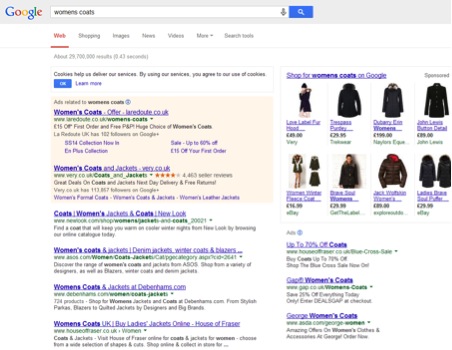Google is constantly changing like fashion; what might be in this month is likely to be out by next month. Relying on one strategy to increase your visibility in Google just isn’t going to cut the mustard. Get your mind in gear and get ready to read our quick fire guide to dominating the elusive first page of Google’s SERPS.
Identify your opportunities
To reach Google domination you need to understand what your opportunities are, and ultimately accept that you can’t have it all. Now, there are countless results that Google can show – you may have seen the epic SERP graphic from Moz here. As to not put you into an early grave I’m going to focus on the ones that I think are most suited to small to medium businesses, and offer tips on how to give your site a strong shot at each type of result.
Paid results
Commonly known as Pay Per Click (PPC) or Google ads/AdWords ads. These are the results you see in the shaded box underneath the search bar and to the right of the organic results.
Being the innovative organisation that they are, gone are the day of standard Google text ads. In their place are text ads with multiple ad extensions including; site link extensions, call extensions, product extensions and location extensions. These give the user more information and increase click through rates on your ads, so utilising these within the AdWords platform is always a bonus. Sitelinks should go to related products based on your ad group and location extensions should be used when trying to attract local customers.
Organic results
These are results that Google indexes based on their algorithm. Anyone implementing SEO is doing this with the end aim of appearing higher in Google organic results. Unless you have very niche keywords, ranking number 1 in Google is not going to happen overnight. However you should do everything you can to increase your chances of doing so and starting to make your way up the ranks.
Make sure you have covered the basics of SEO off on your site such as meta-data, good unique content and quality links. Ensure you have profiles on the major social networks including Facebook and Twitter – these can rank above your website so take advantage of this.

Google+
Google+ is Google’s own social network. I view it as a hybrid between Facebook and LinkedIn as it has elements of both. Creating a Google+ profile, both personally and for your brand is pretty much vital these days. Firstly Google+ is owned by Google so it is a bit of a no brainer. Secondly, social should be part of your SEO strategy.
Make the most of tools such as Google Authorisation and optimise your profile to its fullest by filling out all fields and linking appropriately to your site.
Images
Images are a result Google will show for a range of user searches. If you add images to your site optimise them by naming them with logical, keyword rich file names. Images appear highly in the SERPs so take advantage and build image optimisation into your SEO strategy. Don’t forget your logo is the most obvious image you should optimise – including file name, alt tag and URL.
Google+ Local (Google Maps)
This links back to Google+. To make things confusing, Google gives you the option to create:
- A personal Google+ profile
- A company Google+ page
- A Google+ Local page for your company
Google+ local is the updated version of Google Maps listings. If your audience is location based then this is an item you should definitely have ticked off your list. Setup your listing, get it verified and link it to an appropriate landing page.
This is essential for companies that have multiple locations because like images, Google+ Local listings appear higher then web page results. Recently Google updated this (surprised? You shouldn’t be!) and the Google+ local listings can now appear on the right hand side of the ads and organic listings. These right rail listings offer the user a lot of useful information, so make sure your Google+ local is optimised to its full potential!
This brief guide to taking advantage of Google SERPS should lay the foundations for you to maximise your business’s online presence. Google’s Rich Snippets give you the opportunity to showcase you and your brand in a magnitude of options, but it’s down to you to determine what’s most suitable and then how to get there. If you’re looking for assistance into improving your SEO presence, you can get in touch with us at Upperdog on 01202 853 642 or via our online contact form here.